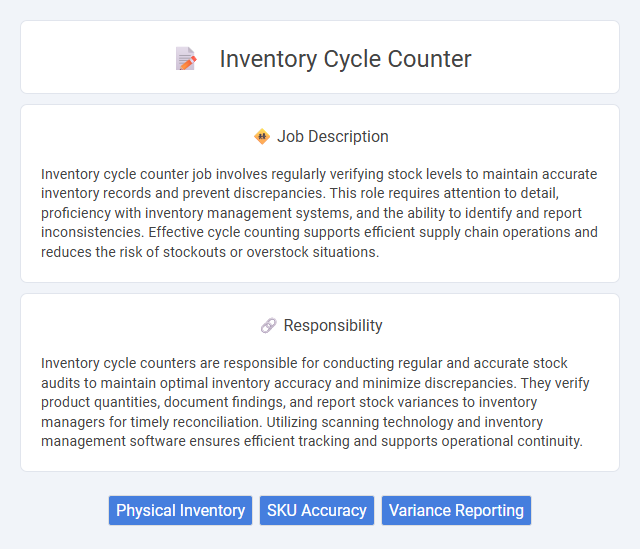
Inventory cycle counter job involves regularly verifying stock levels to maintain accurate inventory records and prevent discrepancies. This role requires attention to detail, proficiency with inventory management systems, and the ability to identify and report inconsistencies. Effective cycle counting supports efficient supply chain operations and reduces the risk of stockouts or overstock situations.
Individuals with strong attention to detail and a methodical mindset are likely to excel in an inventory cycle counter role. People who can maintain focus during repetitive tasks and possess good organizational skills may find this job particularly suitable. Those who struggle with sustained concentration or prefer dynamic work environments might face challenges in this position.
Qualification
Inventory cycle counters must possess strong attention to detail and experience with inventory management systems such as SAP or Oracle. Proficiency in data entry, barcode scanning technology, and basic math skills are essential for accurate stock verification. Effective communication skills and the ability to work independently or within a team environment enhance job performance in maintaining inventory accuracy.
Responsibility
Inventory cycle counters are responsible for conducting regular and accurate stock audits to maintain optimal inventory accuracy and minimize discrepancies. They verify product quantities, document findings, and report stock variances to inventory managers for timely reconciliation. Utilizing scanning technology and inventory management software ensures efficient tracking and supports operational continuity.
Benefit
Inventory cycle counters likely enhance stock accuracy by regularly verifying product quantities, reducing discrepancies that can cause supply issues. This proactive approach probably leads to improved inventory management, minimizing costly stockouts or overstock situations. Consistent cycle counting may also increase operational efficiency, supporting smoother warehouse workflows and better decision-making.
Challenge
Inventory cycle counter jobs likely involve challenges such as maintaining accuracy in fast-paced environments where discrepancies can easily occur. The role may require navigating complex inventory systems while ensuring minimal disruption to daily operations. Workers probably face pressure to detect errors quickly and adapt to varying stock levels and product movements.
Career Advancement
Inventory cycle counters play a crucial role in maintaining accurate stock records, which directly supports efficient supply chain management. Proficiency in inventory control techniques and data analysis can lead to advancement opportunities such as inventory manager, supply chain analyst, or operations supervisor. Developing skills in inventory software systems and quality assurance enhances career growth within logistics and warehouse management sectors.
Key Terms
Physical Inventory
Inventory cycle counters perform regular physical inventory counts to ensure accurate stock levels and identify discrepancies in warehouse or retail environments. They verify product quantities by physically counting items, recording data, and reconciling differences with inventory management systems. Accurate cycle counting supports efficient stock control, reduces shrinkage, and improves order fulfillment accuracy.
SKU Accuracy
Inventory cycle counters play a crucial role in maintaining SKU accuracy by systematically verifying product quantities and conditions within warehouse operations. Their meticulous audits help reduce discrepancies, ensuring data integrity in inventory management systems and supporting efficient supply chain processes. Consistent SKU accuracy achieved through cycle counting minimizes stockouts and overstock situations, optimizing overall inventory performance.
Variance Reporting
Inventory cycle counter roles emphasize accurate data collection during regular stock audits to identify discrepancies between physical counts and inventory records. Detailed variance reporting highlights inconsistencies, enabling timely investigation and correction of inventory shrinkage or misplacements. This process supports maintaining accurate inventory levels, optimizing supply chain efficiency, and reducing financial losses.
 kuljobs.com
kuljobs.com